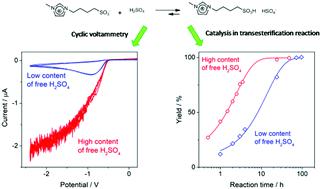当前位置:
X-MOL 学术
›
Phys. Chem. Chem. Phys.
›
论文详情
Our official English website, www.x-mol.net, welcomes your
feedback! (Note: you will need to create a separate account there.)
Insights on the catalytic behaviour of sulfonic acid-functionalized ionic liquids (ILs) in transesterification reactions – voltammetric characterization of sulfonic task-specific ILs with bisulfate anions
Physical Chemistry Chemical Physics ( IF 2.9 ) Pub Date : 2021-1-15 , DOI: 10.1039/d0cp05674j María B. Martini 1, 2, 3, 4 , José L. Fernández 1, 2, 3, 4, 5 , Claudia G. Adam 1, 2, 3, 4
Physical Chemistry Chemical Physics ( IF 2.9 ) Pub Date : 2021-1-15 , DOI: 10.1039/d0cp05674j María B. Martini 1, 2, 3, 4 , José L. Fernández 1, 2, 3, 4, 5 , Claudia G. Adam 1, 2, 3, 4
Affiliation

|
This work shows for the first time the link between the amount of free sulfuric acid (as detected by cyclic voltammetry) and the activity of sulfonic-acid-functionalized ionic liquids (ILs) as acid catalysts for a transesterification reaction, and demonstrates that sulfonic acid groups, while are not directly involved in the catalysis, release the free acid during the reaction. Two imidazolic ILs with bisulfate as the counterion and their corresponding task-specific ILs (TSILs) that resulted from the addition of a sulfonic acid group inside the imidazolic-base structure were studied. The outstanding catalytic activity at room temperature of the TSILs 1-(4-sulfonic acid)-butyl-3-methylimidazolium bisulfate ([bsmim]HSO4) and 1-(4-sulfonic acid)-butyl-imidazolium bisulfate ([bsHim]HSO4) for the transesterification of p-nitrophenyl acetate with methanol was associated to the significant amounts of free sulfuric acid in equilibria with the ionic pairs. It was concluded that these TSILs function as reservoirs for releasing the free acid, which is the actual acid catalyst. In contrast, the corresponding non-sulfonic ILs supply very little amounts of free acid and consequently present low catalytic activities at room temperature, which in fact can be improved by increasing the reaction temperature up to 100 °C.
中文翻译:

磺酸官能化离子液体(ILs)在酯交换反应中的催化行为的见解–磺酸任务特定的ILs与硫酸氢根阴离子的伏安法表征
这项工作首次显示了游离硫酸的量(通过循环伏安法检测)与作为酯交换反应的酸催化剂的磺酸官能化离子液体(ILs)的活性之间的联系,并证明了磺酸虽然这些基团不直接参与催化,但在反应过程中释放出游离酸。研究了以硫酸氢盐为抗衡离子的两个咪唑类ILs及其对应的特定任务ILs(TSILs),这些ILs是在咪唑基结构内部添加磺酸基而产生的。TSILs 1-(4-磺酸)-3-甲基咪唑鎓硫酸氢盐([bsmim] HSO 4)和1-(4-磺酸)-丁基-咪唑鎓硫酸氢盐([bsHim])在室温下具有出色的催化活性。HSO4)对-乙酸对硝基苯酯与甲醇的酯交换反应与大量游离硫酸和离子对平衡有关。结论是这些TSILs充当释放游离酸的储存器,而游离酸是实际的酸催化剂。相反,相应的非磺酸类ILs很少提供游离酸,因此在室温下催化活性较低,实际上可以通过将反应温度提高到100°C来改善。
更新日期:2021-01-25
中文翻译:

磺酸官能化离子液体(ILs)在酯交换反应中的催化行为的见解–磺酸任务特定的ILs与硫酸氢根阴离子的伏安法表征
这项工作首次显示了游离硫酸的量(通过循环伏安法检测)与作为酯交换反应的酸催化剂的磺酸官能化离子液体(ILs)的活性之间的联系,并证明了磺酸虽然这些基团不直接参与催化,但在反应过程中释放出游离酸。研究了以硫酸氢盐为抗衡离子的两个咪唑类ILs及其对应的特定任务ILs(TSILs),这些ILs是在咪唑基结构内部添加磺酸基而产生的。TSILs 1-(4-磺酸)-3-甲基咪唑鎓硫酸氢盐([bsmim] HSO 4)和1-(4-磺酸)-丁基-咪唑鎓硫酸氢盐([bsHim])在室温下具有出色的催化活性。HSO4)对-乙酸对硝基苯酯与甲醇的酯交换反应与大量游离硫酸和离子对平衡有关。结论是这些TSILs充当释放游离酸的储存器,而游离酸是实际的酸催化剂。相反,相应的非磺酸类ILs很少提供游离酸,因此在室温下催化活性较低,实际上可以通过将反应温度提高到100°C来改善。










































 京公网安备 11010802027423号
京公网安备 11010802027423号